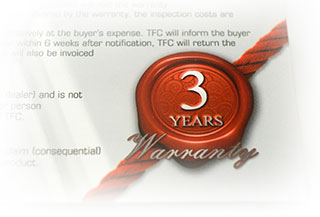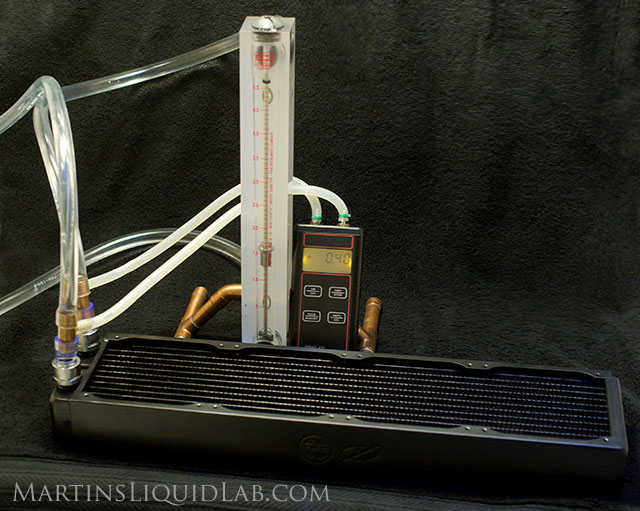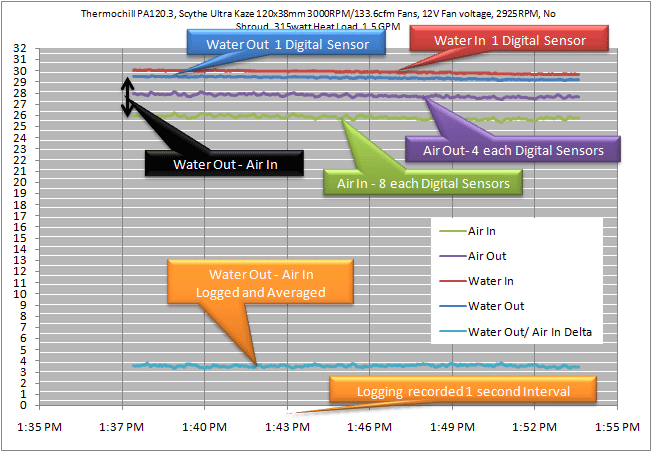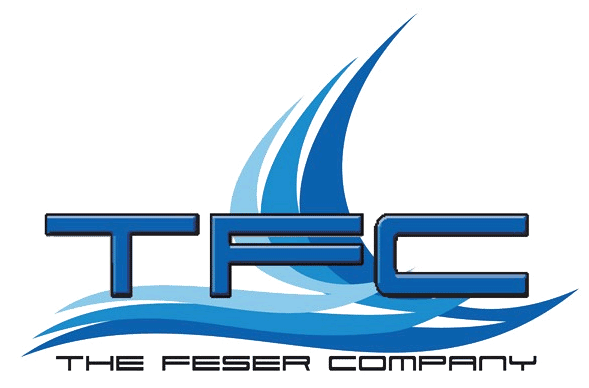

TFC XChanger 480ER Radiator Review
Introduction
Welcome to my review of The Feser Company (TFC) X-Changer 480ER radiator. This radiator would be of the "double thickness quad" sized radiator specifically designed for those that must have the absolute highest radiator performance with silent fan systems. First I would like to give special thanks to Martin from The Feser Company for providing me with a sample to test. The Feser Company is based out of Germany and coming out with many high quality products for your water cooling needs. Check out their website for the latest developments in water cooling technology.
With this review I plan to cover radiator characteristics,
hydraulic restriction, and thermal performance with a wide range of
fans. I'll follow my typical engineering/technical flavor and
keep the commentary to the point about my results and observations. In the end, I hope to provide
you with some tools to help you design your water cooling system with
this radiator. While I'll touch on some comparisons, the ultimate
goal is to help you better understand how heat load and fan selection
affects the performance of this radiator as well as hydraulic
restriction.

Radiator Characteristics
Here are some characteristics I noted in my review:- Double Thickness/Dual Row provides increased efficiency in transferring of heat from the fins to the air.
- Dual pass flow - Water flows down one half of the radiator and back up for a second pass before exiting.
- Separate top plenum chambers prevents any possibility of internal leaks and ensures 100% of the water flows through the radiator tubes.
- 12 tubes per row (24 total) - Oversized dimensions maximize frontal surface area
- Copper louvered fins - Copper material and louvers for maximum air heat transfer.
- G 1/4 Threads - Water cooling standard for maximum barb compatibility
- Dimensions- 523mm x 126mm x 60mm (L x W x H) - For details see this drawing from TFC.
- Silent Fan Optimized Fin Density - 214 folds per the 19 inch frontal length or 11.3 FPI - Optimized for lower speed fans.
- Built in shroud of approximately 1/4" depth - Minimizes fan hub dead air space affect.
- Bleed screw in bottom plenum chamber for air removal assistance if needed (Inverted barb orientation).
- 3 year warranty is standard - Quality is guaranteed!

Standard G1/4 barb threading will accept a wide array of barbs.
Also note the individual plenum chambers to prevent any possibility of flow bypass.

Here you see the TFC signature logos and bottom bleed screw to assist with air removal if the radiator is mounted vertically with barbs on bottom.

TFC also sells their products at local retail shops, so they employ a very nicely presented set of documentation and packaging.

Including a 3 YEAR WARRANTY!
Radiator Package Contents
- TFC XChanger 480ER comes air sealed in a thick plastic bag which ensure moisture protection and prevents damage from small objects.
- 4 Noise absorbing silicone pads for fan vibration absorption and sealing.
- M3 screws for 120mm fans and case mounting
- Documentation - Introduction, Features, Warranty, Serial Number, and Instructions.
- 50ml TFC Feser Base
- 2X Compression Fittings
Hydraulics and Pressure Drop Testing
The most scientific way to determine a blocks hydraulic resistance is to test pressure drop. Pressure drop is a measurement of pressure loss across a radiator that varies with flow rate. This is basically a measurement of energy loss, and directly influences how much flow rate you will have.
- Dwyer Digital Manometer 477 Mark V - Accuracy .5% of Full Scale. Range 0-20.00 PSI range, Resolution .01 PSI
- King Instruments 7520 Series 0-5GPM, 250mm scale - Accuracy 2% of Full Scale. Range 0-5GPM, Resolution .1 GPM (can be interpolated to .02GPM)
- Water Source - Household water pressure - 50PSI at >5GPM - Because flow
rate readings are instantaneous, household tap water and water pressure are a
good and powerful source for pressure drop testing.

Pressure drop testing shows the 480 is extremely low in restriction, several times lower than an average CPU block.

This pressure drop testing was ran with the above TFC 1/2" ID X 3/4" Feser compression barbs.

TFC XChanger 480ER is KING of Quad radiators for the lowest restriction, very nice!!
While benefits to increase flow rates are generally small beyond 1.0GPM for most water blocks, a lower restriction component like the radiator does provide you a fair amount of flexibility. This lower restriction does provide either more pumping power for you to use in adding more components (more blocks or radiators) without impeding flow too much, or it offers you higher flow rates for higher efficiency of your CPU block. In addition these higher flow rates generally mean your system will bleed air faster when initially setup.
Also keep in mind my thermal testing is all based around a 1.5GPM fixed flow rate, so because this radiator is very low in restriction is very possible you could attain higher than 1.5GPM and slightly better thermal efficiency and performance than I've captured here.
Thermal Testing Specifications
Welcome to my thermal testing of this radiator, but first I would like to give special thanks to Linus from NCIX.com for providing me with two sets of fans for testing. They provided me with both the Yate Loon D12SL12 slow speed 47cfm 120x25mm fans, as well as this Scythe Ultra Kaze DFS123812-3000 high speed 136cfm 120x38mm fans. Both fans present great value and a strong variety of cfm coverage for different setups.For a more complete understanding of fan performance vs noise, I would recommend Vapor's fan testing on a radiator, Round 2, Round 3. Comparing actual CFM on a radiator vs noise is the ideal means to compare fans. In addition pay particular attention to his comments about undervolting noise, because decibels by themselves don't tell you if it's a pleasant smooth or clicking type noise that is also very important.
I'm taking the "Scientific" approach to testing the radiator, and doing so by using and measuring an external heat source and apply two heat loads across 5 different fan scenarios. Using the two heat loads allows me to check my work, average out error, and use higher heat loads than needed for measuring larger differences. In addition this testing allows me to use more accurate thermal sensors than those available in a processor. In the end I am then able to calculate a linear c/w ratio trendline for each fan type. This is a very handy ratio for estimating, (c/w stands for degrees Celcius above ambient per watt of heat). Having the c/w ratio allows you to estimate the water temperature for any heat load....ahhh we have science and a TOOL!. Furthermore, because I'm testing over a large range of fan scenarios, I can then plot the fan RPM relative to the c/w values generated. While RPM from two fan types is not a direct performance relation (Pressure is equally as important), it surprisingly still creates a decent fan power trend-line curve. Regardless, the real advantage to doing this RPM vs C/W chart is gaining a much bigger perspective on how the radiator's performance changes over the use of different fan types. In general you will see as radiators are more dense and thicker, they will have a larger variance in performance from the lower speed/pressure fan types to higher speed fan types. You will also see that radiators that are more open finned generaly perform better with lower speed fans than those with much more dense fin structure.
In addition to the "Scientific" approach, I'm also going a bit extreme on the sensors I'm deploying to measure all of this. Because this c/w ratio is a measurement of "Air" into the radiator, you have to seriously consider how much variability there is in air temperatures throughout a room and even across different points on the radiator. Air is actually considered an insulator, so if you don't measure air at several locations and average them, the amount of error is much higher than you would expect. Some of the measurements may only be a few degrees at lower heat loads, so it's almost a must to measure with higher accuracy thermometers, use several to measure several points, and log temperatures over a long period of time to average out fluctuations. With that, I've decided I would employ at least two digital air in sensors per 120mm section of radiator with a .2C mean error, and of course logging temperatures over at least 30minutes after an appropriate 30minute warm up period. All of this helps make up for the fact that I do not have an environmental chamber with controlled and consistent air temperatures.
With all of this, I'm able to get a pretty good and accurate understanding of how you can estimate performance depending on the fan used and generate some good information for you to use. Below are some more details and links of the radiator testing equipment used:
Radiator Testing Specifications:
- Thermal Temperature and Fan RPM Monitoring - CrystalFontz CFA-633 32 Channels of temperature, 4 channels of fan RPM, Logging Capability in CSV format exportable to excel, .5C absolute accuracy. Used to log 14 individual temperature sensors and one fan RPM sensor to log results at 1 second intervals. Here is a small data example of what just one run looks like which is logged in the below chart, thankfully the Crystalfontz does most of the work for me.
- Thermal Sensors - Dallas DS18B20 Digital one-wire sensors. .5C absolute accuracy overall with a .2C mean error between 20-30C.
- Heat Source - Two modified 300watt aquarium heaters. I've taken the thermostat out of two heaters, and run two tests. One with just one heater and one with the other. Both of these heaters reside in my 4" custom reservoir and wattage is determined by a Kill-a-watt that the heaters are plugged into.
- Test Bench Sensors Deployed -
- 8 each air inlet sensors, two for each 120mm fan section
- 4 each air outlet sensors, 1 for each 120mm fan section
- 1 water inlet sensor
- 1 water outlet sensor

- Custom Test Bench - Custom built 120mm x 4 radiator test bench with permanently mounted sensors to improve consistency and minimize setup time.
- Flow rate - King Instruments 7520 Series 0-5GPM, 250mm scale - Accuracy 2% of Full Scale. Flow rate is controlled via 3/4" brass gate valve to precisely 1.5GPM. Flow rate effects are generally minimal in radiators so I have selected 1.5GPM as a good average flow rate point although there will be some small benefit if higher than 1.5GPM flow rates are obtained, it's generally fairly small.
- Water - I used regular filtered tap water for testing purposes.
- Warm-up - Each fan configuration is allowed to reach temperature for at least 30 minutes prior to recording and logging of temperatures. Typically it takes about 20minutes for the high speed fans to reach equilibrium and 30minutes for the low speed fans.
- Fans:
- Yate Loon D12SM12 120mm x 25mm - 70.5cfm/1350 RPM/33 db (open air)
- Ultra Slow Speed Fans - Undervolted to 1000 RPM
- Slow Speed Fans - Undervolted to 1350 RPM
- Medium Speed Fans - Voltage adjusted to 1550 RPM
- Scythe Ultra Kaze DFS123812-3000 - 136cfm/3000 RPM/45.9 db (open air)
- High Speed Fans - Undervolted to 2000 RPM
- Ultra High Speed Fans - Voltage adjusted to 2930 RPM
- Logging of Temperatures - Each temperature sensor and fan rpm channel is logged for at least 30 minutes to both average out any temperature fluctuations and also to ensure the system has stabilized and heat loads/fan RPMs remained constant during the testing period. If temperatures did not fluctuate or an error occurred, the test was thrown out. Over a 30 minute period data for all 14 temperature sensors and fan header are recorded every second producing a data matrix of 1,800 entries over each channel.
- Air Inlet Temperature Data - Each test averages the 8 inlet channels (6 in the case of a triple radiator), and then average over the testing period of 1,800 results. So Air In can be the average of up to 8 x 1800 = 14,400 data points collected.
- Water Outlet Temperature Data - Water outlet data is also captured by the same Dallas sensor with an average of 1,800 data points collected.

- Fan RPM - Also recorded and monitored with the Crystalfontz. Fan RPM is
carefully adjusted using a Sunbean fan speed controller to be the following:
- 12V Full Speed - Each fan is first adjusted to 12.00V +- .05V for the full speed test runs
- RPM - Subsequent fan scenarios are voltage adjusted to match RPMs as specified with 10RPM.
- Open Environment Testing - I also wanted to note, that I am not insulating the coolant lines, my flow rate meter, or my reservoir, so the c/w values I generate are for the complete system. I am using about 6' of 1/2" ID by 3/4" tubing, a 14" King Instruments flow meter, a 3/4" brass gate valve, and at tall 4" diameter by 24" tall reservoir which do loose some heat during testing. Initially I had thought about insulating my system, but the more I've thought about it, a regular water cooling system also looses heat through tubing and reservoirs, so I think it's an acceptable heat loss that is similar to normal water cooling systems. I also have and will continue to test every radiator exactly the same, so they all have these same heat loss advantages through the test system. The one variable I can't fix is the ambient temperature changes, and there is some differences in thermal properties of air as it changes. I think they are probably small enough to keep my results within 5% or so, but it's still something I don't have control over where an environmental chamber would be ideal.
Thermal Testing
For testing consistency purposes I always mount my fans with preinstalled 1/8" foam sealed to the edges. This is not necessary as the provided TFC silicone gaskets provided are exceptionally well made, but in essence of testing radiators equally, I followed suit and tested as shown below with the fan snugly sealed to the radiator without anything but the foam gasket sealing any air gaps. Note that I also always test with the fans in "PULL" condition such that air is sucked through the radiator like a vacuum.

These were my tabular results of the 10 hour long tests without any shroud.
Note that under ultra slow speed fans it manages over 85% air capacity efficiency, very nice!!

And this is plotting the water delta vs heat load and assuming a linear trend-line. One thing I noticed is that the linear trendline didn't fit very well over several curves particularly for the middle fan scenarios. I'm not quite sure why, but for now I just assumed a linear relationship to average the two heat loads.
- Extreme Outer Visions PSU calculator - Just note heat load minus the 38 watts included in the start.
- Swiftech's Conroe/Kentsfield CPU calculator - This is actual an estimator for the kit, but it also gives what I think is a more accurate heat load for the processor. Just plug in the field and it will output a heat load in watts.
So what does this water temperature mean? You are cooling with the water that leaves your radiator and enters your CPU block. So any improvement in this number will directly translate into an improvement in your CPU temperature. For example if your water temperature delta is 10C and your loaded core temperature was 50C. If you improved your water delta by 5C either by adding another radiator or increasing your fan performance, your new core temperature will be 45C assuming your ambient temperature remained the same.
To take it and break it down in a few additional curves:

These are the c/w values generated from the test system assuming a linear relationship between heat loads.

And by popular demand, here is a conversion of c/w to a 10C delta heat dissipated chart vs RPM.
I consider 10C delta average performance and a 5 C delta, high performance, but that's probably subjective.

And this is the same thing with the 5C delta.
480 Comparison
So, you might be wondering, how do the two King radiators perform. While there are a few other quad radiators out there, I've only tested the HWlabs 480GTX, and the TFC XChanger 480ER which I'll compare here.
First up a quick look at c/w values, the closer you approach 0, the more significant the difference.

And converting that to 10C heat dissipated, this gives you more of a numbers look.
The TFC480ER is dominating under 1880 RPMs, and the HWlabs 480GTX is flexing it's high density muscle in the fans greater than 1880RPM. The TFC480ER is dissipating approximately 29% more heat at the Ultra Slow speed category, and about 27% less in the Ultra High speed category.
Bottom line, at 1880RPM they are equal, anything slower and the TFC XChanger 480 is superior, anything faster and the 480GTX is superior.
Personally I am a fan of the "Slow Speed" fans at around 1350RPM range, so for me...the TFC 480ER would be the quad radiator of choice as it would afford me about a 22% improvement over the 480GTX. In addition the TFC 480ER provides a fair amount lower restriction for my loop and will maintain higher flow rates and bleed faster which is helpful for quick bleeds in CPU block testing.
I'm currently soliciting a poll on XS to try and better understand what the user base is out there for fan speed/noise preference.
My results of that poll as of 7-4-08 were as follows: ( I will update this as I get more votes in, currently showing 73 votes)

So from these polled survey results, most users prefer the 1350 Slow Speed and 1550 Medium speed categories along with a somewhat suprising high number of Ultra Slow speed users. During the poll I also had quite a few people educate me in that 1000RPM is not slow enough, many folks run fans down to 500, 700, and 800 RPM ranges. It appears about 80% of the users surveyed would really benefit from the low fan speed optimizations that this radiator provides.
And for the last chart, here are some assumed heat load scenarios for you to get a better sense of what all this c/w and watts dissipated means for temperatures.


TFC 480ER No Shroud Water Temperature Estimator Spreadsheet
If you want to tinker with heat loads and fan results, rather than using the charts, I've created this quick little spreadsheet where you can enter in your own heat load and ambient temperature. It will then show you the estimated water temperatures based on the results I gathered above.Note this is for informational and educational purposes only.
TFC480EREstimator.zip
97-2003 Microsoft Excel (.xls) format
TFC Shroud Options
TFC also provided me with some of their universal shrouds which can be used on any 120mm radiator, they come with a very nice antivabration gasket and dual molex powered LED light. They also sell the LED lights in several different colors.
Here is the packaging contents which includes screws for 25mm thickness fans mounted to the shrouds.

They are extremely nicely fabricated acrylic units, note the fine detail here.
I'm saving these shrouds for some later separate fan/radiator experiments. These are exceptionally nice shrouds and finally provide the water cooling community a quality and nice looking universal shroud for any radiator, very nice!
Pros
- The NEW QUIET KING of ultra slow, slow, and medium speed fans! (Most thermally efficient quad radiator for the most common fans)
- Extremely high quality construction backed by a 3 year warranty
- Extremely low pressure drop means maximum flow rates for your water blocks, excellent for multiple block/radiator loops!
- Open finned design and double thickness is optimized for the highest efficiency using low speed fans
- Quad 120mm fan design offers EXTREME performance
- Copper tubes for maximum heat transfer
- Bleeding screw for installation bleeding assistance
- G1/4 threading offers compatibility with all standard G1/4 barbs.
- Matching TFC shroud options
Cons
- Large Quad Size - Personally I like the larger sized radiators, but depending on the intended installation location, you should plan for it.
- Cost - Like anything in life, premium performance comes with a higher cost. Fortunately the radiator is one of the few computer components you can continue to use and reuse for many many years, so it is one of the few "long term" investments in computer performance you can make.
Bottom Line
The TFC X-Changer is an exceptionally well engineered and constructed radiator. For users who prefer fans under 1880 RPM, it is THE KING of dissipation for quad radiators that I have tested to date. It is extremely well constructed and quality control is top notch. Since I prefer fans of the slow speed or 1350RPM range, this is the single best quad radiator I can use for my fan preference. This is an amazing radiator!!Where to buy
This radiator is a prototype, but I understand these will soon hit the shelves of your favorite water cooling shops at around a retail$199 USD includes:
- TFC XChanger 480ER
- 2X 3/8" ID x 1/2" OD Compression Fittings
- 1 50ml Feser Base corrosion blocker bottle
Here is a link to TFC website for details:






